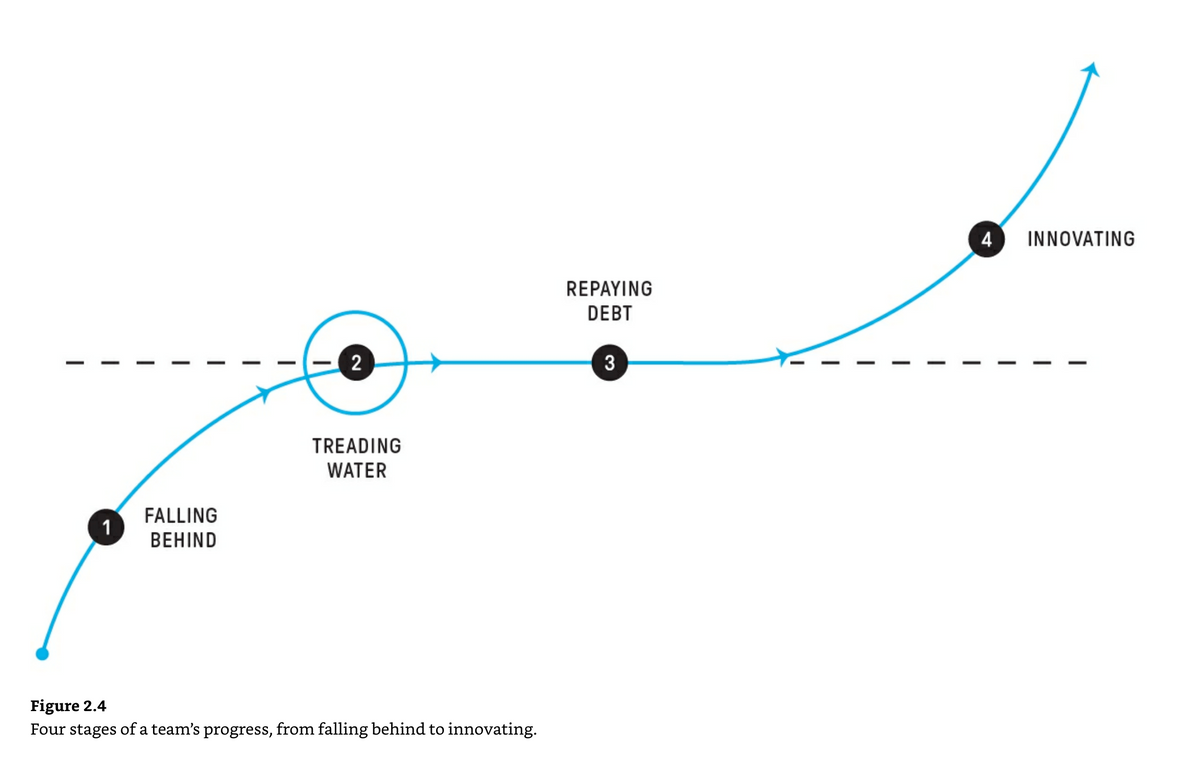Breaking Through the Barriers to Innovation
Progressing from Falling Behind to Innovating!

In the dynamic field of software engineering, the constant flux of change represents both a challenge and an opportunity. A challenge because managing this change can be daunting and an opportunity because successful navigation through this change can lead to innovation. As identified by Will Larson in his book "An Elegant Puzzle: Systems of Engineering Management," software engineering teams typically progress through four stages of change: Falling Behind, Treading Water, Repaying Debt, and Innovating. Here we explore how software engineering teams can traverse these stages, focusing on process and cultural changes required to reach the pinnacle of innovation.
Stage 1: Falling Behind
Falling behind is a natural stage when a team is unable to keep pace with the demands and technological advancements.
Process Changes
- Prioritization: Teams should start by acknowledging the issue at hand and making a list of all tasks in the pipeline. This must be followed by a ruthless prioritization based on the impact on the business and customer value.
- Automation: Automation can drastically increase efficiency, freeing up time for more complex tasks. Automate repetitive and time-consuming tasks wherever possible.
Cultural Changes
- Open communication: Encourage a culture where falling behind isn't seen as failure but as a phase of growth. Open dialogue about the challenges faced by the team can foster solutions from within.
- Learning environment: Adopt a learning-oriented culture, where keeping up with new technologies and tools becomes a norm.
Stage 2: Treading Water
In the treading water stage, the team is able to maintain pace with incoming work but struggles to make significant strides forward.
Process Changes
- Agile practices: Adopt agile methodologies to increase adaptability and response to change. This includes iterative development, stand-up meetings, and a focus on delivering usable software frequently.
- Delegation: Managers should delegate responsibilities, freeing up time to focus on strategic planning and vision.
Cultural Changes
- Feedback culture: Foster a culture that encourages feedback. Both top-down and bottom-up feedback mechanisms should be in place.
- Empowerment: Create a culture of empowerment where each team member feels responsible for the project's success and can make decisions.
Stage 3: Repaying Debt
Repaying debt involves addressing the backlog of issues and technical debt that have accumulated over time.
Process Changes
- Regular audits: Implement regular system audits to identify technical debts and potential security vulnerabilities.
- Time allocation: Dedicate a specific amount of time in your sprint cycles to resolving these identified issues.
Cultural Changes
- Acknowledge and tackle debt: Cultivate a culture that views technical debt as a part of the process, not a failure.
- Shared responsibility: Encourage everyone to take shared responsibility for the accrued debt.
Stage 4: Innovating
This is the ultimate stage where the team has time, resources, and energy to focus on creating novel solutions and approaches.
Process Changes
- Research and Development: Allocate resources and time for R&D. Experiment with new technologies and approaches.
- Innovation Labs: Implement 'innovation labs' where team members can work on passion projects or explore new ideas outside the daily routine.
Cultural Changes
- Foster creativity: Cultivate a culture that encourages new ideas, and rewards creativity and risk-taking.
- Embrace failure: Create a safe space where it's okay to fail. Failures should be viewed as opportunities for learning and not as setbacks.
Reaching the stage of innovation is an arduous journey, but it's not unachievable. With the right process and cultural changes, a software engineering team can steadily navigate from falling behind to innovating. It's important to remember that these stages are not linear and teams may oscillate between them. The journey of innovation isn't a destination but a continuous process of learning, adapting, and evolving.


